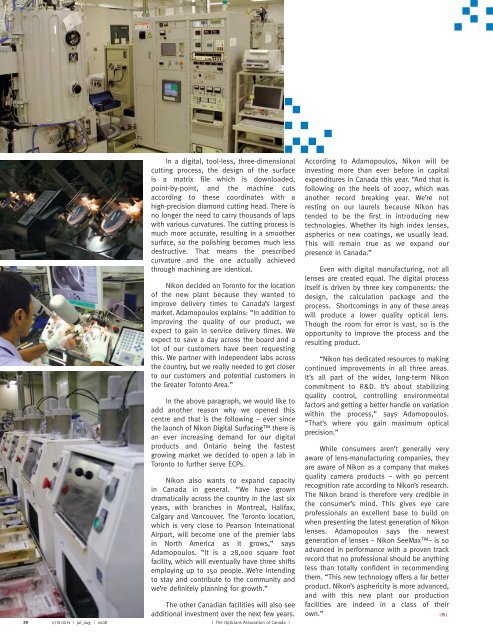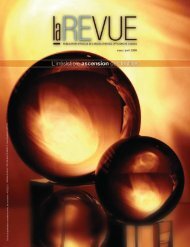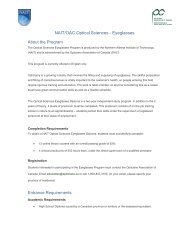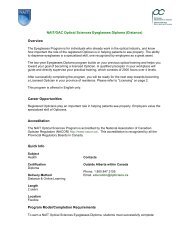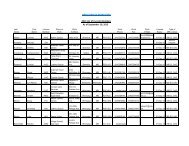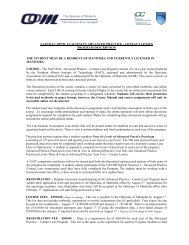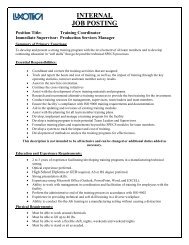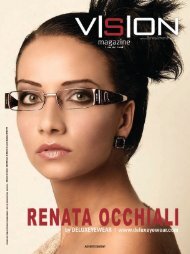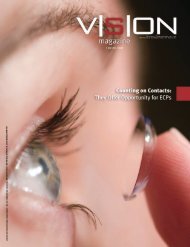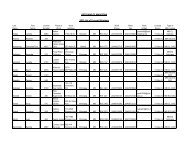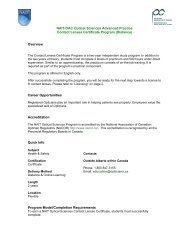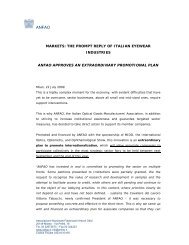Bionic Eye
Bionic Eye
Bionic Eye
Create successful ePaper yourself
Turn your PDF publications into a flip-book with our unique Google optimized e-Paper software.
20<br />
In a digital, tool-less, three-dimensional<br />
cutting process, the design of the surface<br />
is a matrix file which is downloaded,<br />
point-by-point, and the machine cuts<br />
according to these coordinates with a<br />
high-precision diamond cutting head. There is<br />
no longer the need to carry thousands of laps<br />
with various curvatures. The cutting process is<br />
much more accurate, resulting in a smoother<br />
surface, so the polishing becomes much less<br />
destructive. That means the prescribed<br />
curvature and the one actually achieved<br />
through machining are identical.<br />
Nikon decided on Toronto for the location<br />
of the new plant because they wanted to<br />
improve delivery times to Canada’s largest<br />
market. Adamopoulos explains: “In addition to<br />
improving the quality of our product, we<br />
expect to gain in service delivery times. We<br />
expect to save a day across the board and a<br />
lot of our customers have been requesting<br />
this. We partner with independent labs across<br />
the country, but we really needed to get closer<br />
to our customers and potential customers in<br />
the Greater Toronto Area.”<br />
In the above paragraph, we would like to<br />
add another reason why we opened this<br />
centre and that is the following – ever since<br />
the launch of Nikon Digital Surfacing there is<br />
an ever increasing demand for our digital<br />
products and Ontario being the fastest<br />
growing market we decided to open a lab in<br />
Toronto to further serve ECPs.<br />
Nikon also wants to expand capacity<br />
in Canada in general. “We have grown<br />
dramatically across the country in the last six<br />
years, with branches in Montreal, Halifax,<br />
Calgary and Vancouver. The Toronto location,<br />
which is very close to Pearson International<br />
Airport, will become one of the premier labs<br />
in North America as it grows,” says<br />
Adamopoulos. “It is a 28,000 square foot<br />
facility, which will eventually have three shifts<br />
employing up to 150 people. We’re intending<br />
to stay and contribute to the community and<br />
we’re definitely planning for growth.”<br />
The other Canadian facilities will also see<br />
additional investment over the next few years.<br />
VISION | jul_aug | 2008 | The Opticians Association of Canada |<br />
According to Adamopoulos, Nikon will be<br />
investing more than ever before in capital<br />
expenditures in Canada this year. “And that is<br />
following on the heels of 2007, which was<br />
another record breaking year. We’re not<br />
resting on our laurels because Nikon has<br />
tended to be the first in introducing new<br />
technologies. Whether its high index lenses,<br />
aspherics or new coatings, we usually lead.<br />
This will remain true as we expand our<br />
presence in Canada.”<br />
Even with digital manufacturing, not all<br />
lenses are created equal. The digital process<br />
itself is driven by three key components: the<br />
design, the calculation package and the<br />
process. Shortcomings in any of these areas<br />
will produce a lower quality optical lens.<br />
Though the room for error is vast, so is the<br />
opportunity to improve the process and the<br />
resulting product.<br />
“Nikon has dedicated resources to making<br />
continued improvements in all three areas.<br />
It’s all part of the wider, long-term Nikon<br />
commitment to R&D. It’s about stabilizing<br />
quality control, controlling environmental<br />
factors and getting a better handle on variation<br />
within the process,” says Adamopoulos.<br />
“That’s where you gain maximum optical<br />
precision.”<br />
While consumers aren’t generally very<br />
aware of lens-manufacturing companies, they<br />
are aware of Nikon as a company that makes<br />
quality camera products – with 90 percent<br />
recognition rate according to Nikon’s research.<br />
The Nikon brand is therefore very credible in<br />
the consumer’s mind. This gives eye care<br />
professionals an excellent base to build on<br />
when presenting the latest generation of Nikon<br />
lenses. Adamopoulos says the newest<br />
generation of lenses – Nikon SeeMax– is so<br />
advanced in performance with a proven track<br />
record that no professional should be anything<br />
less than totally confident in recommending<br />
them. “This new technology offers a far better<br />
product. Nikon’s asphericity is more advanced,<br />
and with this new plant our production<br />
facilities are indeed in a class of their<br />
own.” ISI


